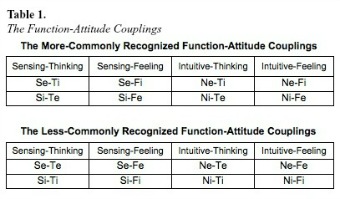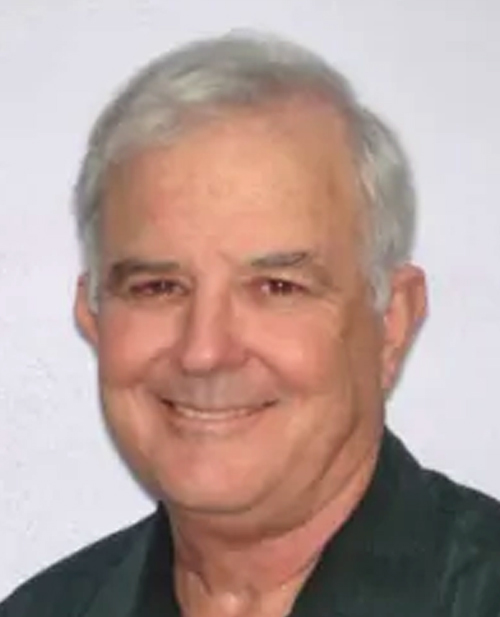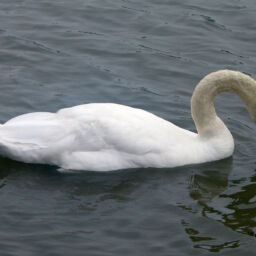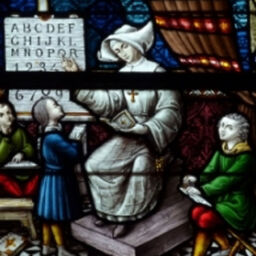
Exploring Function Coupling Interactions
Robert McAlpine and Stephen Weed, July 6, 2017

Giannini’s Model
Giannini’s work focused on the function pairs (Sensing-Feeling, Sensing-Thinking, Intuitive-Feeling, Intuitive-Thinking) as described by Jung and defined by Myers, pairing one perceiving function with one judging function that are together balanced, “in every respect different” (Jung, 1921/1971, para. 669), and exerting “co-determining influence” (para. 666) on our behavior. Giannini explained in Compass of the Soul (2004):
[The] coupling’s two functions are always distinct from one another in their structural and dynamic functions, and we need to be conscious of their specificity. The distinctive traits of each individual type will persist in the couplings, even though the couplings play out archetypal wholes. Also, one of the functions in each coupling, as dominant, is in charge and the other, the auxiliary, acts as an assistant. Finally, in this minidrama, one function will have an extraverted role and the other an introverted role. (p. 169)
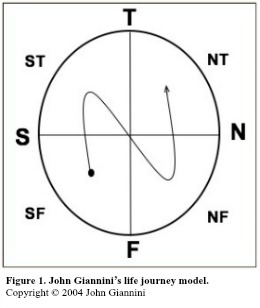
Giannini’s model differs importantly from Myers’ in that it does not restrict us to just one predominant function pair associated with one’s preferred perceiving and judging processes throughout our lifetime. His model provides a greater degree of flexibility in the developmental expression of type-related behaviors as well as enhanced adaptive power for engaging and responding to our various environments. For Giannini, we move through the function couplings early in life and learn to rely on each of the four pairs as needed in adulthood as we move toward wholeness.
Beebe’s Model
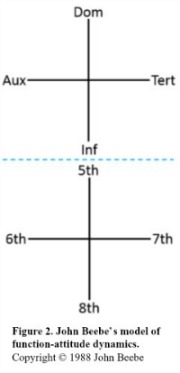
Research Methods
After much discussion and with tremendous uncertainty as to how to proceed, we decided to create a focus group to test the synergy that might result from not only looking at our awareness of using the more-commonly recognized function-attitude pairings, but also of our less-commonly recognized pairings (see Table 1). We wondered if the more-commonly recognized couplings are more easily and consciously expressed and whether or not the less-commonly recognized couplings are expressed with any conscious awareness whatsoever.
The results from the first focus group in Columbus, Ohio, in 2015 indicated that the overwhelming majority of type-aware participants recognized using their dominant-auxiliary, dominant-tertiary, auxiliary-inferior, and tertiary-inferior couplings, but when asked to couple any of their ego-syntonic functions with their ego-dystonic, or shadow, functions, they were not able to readily recognize using the coupling (McAlpine & Weed, 2016).
In that 2015 workshop, we identified each function-attitude coupling in a theoretical context and gave the participants the time to discuss their awareness of using the coupling. The following year in 2016, we asked a second type-aware group to respond to descriptions of how the function-attitude pairs might work together, without identifying the function-attitudes by name or their relative position within the participant’s psyche according to the Beebe eight function-attitude eight archetype model.
The results from the second focus group supported our hypothesis that function-attitude couplings seem to resonate more clearly with participants when the questions focus on the simple descriptions of the two functions and how they might work together. Almost all participants were able to recall experiences of using all of the function-attitude couplings. Many participants were able to recognize couplings that spanned the conscious/unconscious, ego-syntonic/ego-dystonic line, and a number of interesting characteristics of these couplings were consistent across reports from both the 2015 and 2016 groups.
One example of a coupling experience that crossed the conscious/unconscious, ego-syntonic/ego-dystonic line was submitted by a friend who identifies as ESTJ, who found herself having to change a commitment she had made to meet with a group at a certain time. She notified them she would connect with them later in the day, but as the day progressed her plans were again altered by rain forcing her to be later than she had planned. Upon realizing her plans could not be carried out, she felt compelled to immediately inform the group that she would be an hour later than planned, then had to update them on her progress, even though she had never conveyed to them an exact time she would be meeting with them. We saw this experience as an example of ESTJ using her Se-Te (6,1) coupling in that her dominant Te’s need to adhere to a schedule drove her need to update on a momentary basis (Se).
Earlier this year, we decided to shift our research method to a set of brief online surveys in order to increase our sample and data set to include all sixteen types and to provide greater diversity in age, gender, and heritage. The eight separate online surveys spanned several months and attracted almost 100 respondents per survey, drawn from a sample of type-interested individuals with active email addresses. While these surveys allow us to make some initial findings, additional surveys are needed to increase the type and age diversity for a more complete analysis.
Purpose
We wanted to determine whether there is evidence to support Giannini’s idea that each of us may flexibly use all four of the function pairs that Myers identified in our development through adulthood. Also, we wanted to record whether we each are able to consciously use, recognize, and regulate each of the four function pairs in all four function-attitude couplings. For example, when looking at the SF couplings, is there evidence that the coupling is not just expressed in the more-commonly recognized couplings of Si-Fe or Se-Fi, but also in the less-commonly recognized couplings of Si-Fi and Se-Fe? And further, would stories of how these couplings are used provide insight into the archetypal energies that might be present or evoked when the coupling is engaged?
Importantly, we want to also observe, test, and describe our ability to consciously express and regulate the behaviors of the dominant-auxiliary coupling (or primary coupling) and the dominant-tertiary coupling (or secondary coupling) as well as other, more fleeting perceiving-judging couplings such as the auxiliary-inferior and tertiary-inferior couplings (or subordinate couplings), which may prove to be more robust than previously considered. In addition, as early results seem to indicate, these studies may provide support for Beebe’s concept that the function-attitudes are located by position or as a placeholder within his dynamic typological system (not necessarily ordered in a hierarchical structure) and that these positions are associated with certain archetypal energies.
Merging the Models
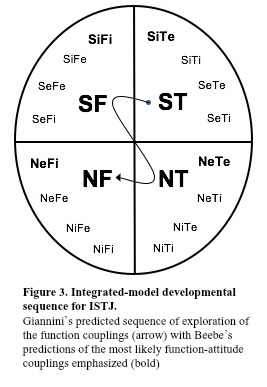
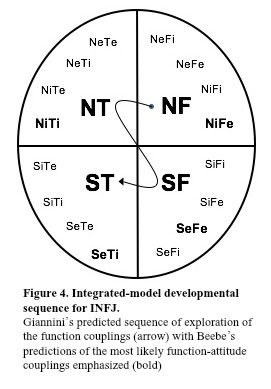
The Story So Far
Our initial analysis of the data is supporting our hypothesis that most people have an awareness of frequent use of both the primary and the secondary function-attitude couplings of the new merged Giannini-Beebe model. This suggests that we are frequently pairing perceiving and judging functions in the same attitude (the secondary coupling)—a combination not normally mentioned in the functional pairs or function-couplings literature. The initial analysis is also indicating that we may have use of all of the function-attitude couplings to some extent, regardless of where the function-attitudes reside in our type dynamics framework. Finally, the archetypal energies associated with many of the positions can be easily spotted in the examples provided by many of the survey participants.
The influence of the trickster archetypal energy from the function-attitude in the seventh position can be seen in the following two examples: (1) An INFP reported that she finds being the host at parties to be extremely exhausting as she is constantly on watch to see if someone appears to need something, and rushing in to fulfill that need, whether or not they actually need anything. She has often found that her Se-Fe (7,5) coupling tends to misread her guests’ body language in the immediate moment, creating situations where she perceives needs where none actually exist. (2) An INTJ reported that in situations where he’s consciously paying attention to others’ non-verbal cues, he tends to respond almost compulsively to “fix” others’ problems, whether or not his help is needed. He finds that, as with the INFP example above, his Se-Fe (4-7) coupling tends to misread appropriate social information and drive him to “fix” others as a way of helping in the immediate situation.
Looking Ahead
This work is just the first step, and further analysis of the both the focus group reports and online survey data is currently underway. However, we are extremely excited about the possibilities of providing research that supports the flexible use of all of the sixteen function-attitude couplings by all sixteen personality types. We look forward to sharing these results in greater detail and definition at the upcoming Biennial Conference of the Association for Psychological Type International in Salt Lake City in July 2017.
Both authors wish to thank the workshop participants and survey respondents who have contributed to this research over the past three years, and without whom this work would not be possible.
References
Beebe, J. (2007). Type and archetype. Typeface, (40)2, 8-12, (40)3, 22-27. Retrieved from https://www.capt.org/MILO/TypeFace.htm?bhcp=1
Beebe, J. (2017). Energies and patterns of psychological type: The reservoir of consciousness. London and New York: Routledge.
Giannini, J. (2004). Compass of the soul: Archetypal guides to a fuller life. Gainesville, FL: Center for Applications of Type, Inc.
Giannini, J., McAlpine, R., & Valentine, G. (2013-2014). Chatting with John Giannini [Webinar]. In Type Resources Webinar Series.
Jung, C.G. (1921/1971). Psychological types. In: R.F.C. Hull (Trans.). The collected works of C.G. Jung (Vol. 6). Princeton, NJ: Princeton University Press.
McAlpine, R., & Weed, S. T. (2016). Breathing life into the function pairs. Association for Psychological Type International Bulletin, (40)5. Retrieved from http://www.aptinternational.org/
Myers, I., & Myers, P. (1980). Gifts differing: Understanding personality type. Palo Alto, CA: Davies-Black.
Newton, I. (1676). Letter to Robert Hooke. Retrieved from https://www.brainyquote.com/quotes/quotes/i/isaacnewto135885.html
Images
Header image: “Hevajra Mandala” 17th century. Courtesy: Rubin Museum of Art.
Figure 1. John Giannini’s life journey model. Copyright © 2004 John Giannini
Figure 2. John Beebe’s model of function-attitude dynamics. Copyright © 1988 John Beebe
Table 1. The Function-Attitude Couplings
Figure 3. Integrated-model developmental sequence for ISTJ. Giannini’s predicted sequence of exploration of the function couplings (arrow) with Beebe’s predictions of the most likely function-attitude couplings emphasized (bold)
Figure 4. Integrated-model developmental sequence for INFJ. Giannini’s predicted sequence of exploration of the function couplings (arrow) with Beebe’s predictions of the most likely function-attitude couplings emphasized (bold)
In Memoriam
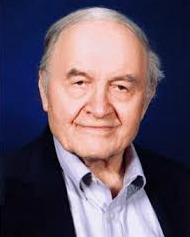
Giannini was impassioned on the subject of evil and patriarchal traditions, and he believed Jung wrote his controversial “Answer to Job” as a cry against the patriarchal domination of western Christian culture. His Compass of the Soul, 2004, brought together many of his interests including the maternal principle, business culture, type development, function couplings, the cultural type of America, and the way economist W. Edwards Deming engineered the postwar “Japan miracle” by putting Jungian concepts into practice in the workforce. Giannini’s concept of the function couplings is an extension of Jung’s observation that no function ever works alone, and led Giannini to insights about the way the psyche achieves balance and navigates the individuation journey. John Giannini leaves a profound legacy that goes well beyond his intellectual insights, of warm-hearted patience, humility, and acceptance among his many friends and acquaintances in the type and analytical communities.
—The Editors, Personality Type in Depth


